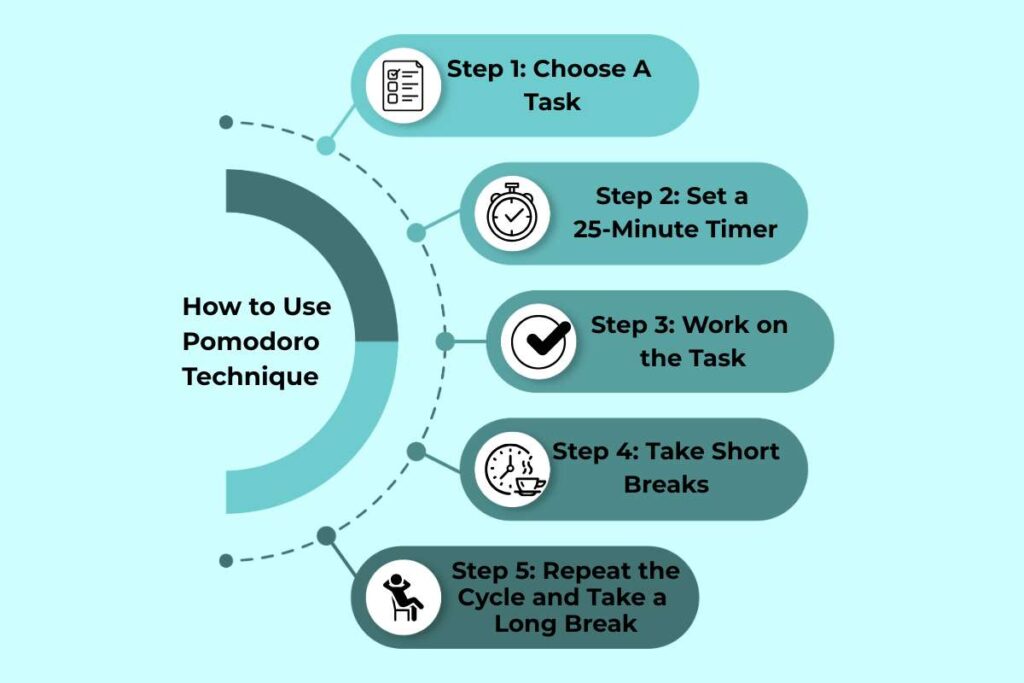Do you have a hard time staying focused? Are your tasks piling up and making you feel lost? Well, I am here to introduce you to the Pomodoro Technique. It is an easy but effective method for time management and boosting your productivity. If you get distracted easily and lose track of time, this is a method you need to try. Not only will it get your things done, but it will also encourage healthier habits and a better lifestyle.
So, what is Pomodoro technique and how does it work? That’s exactly what we will try to learn in this blog. So, let’s get started.
What is Pomodoro Technique?
The Pomodoro technique was invented by Francesco Cirillo in the 80s. The technique’s name comes from the Italian word for tomato, as Cirillo used a tomato-shaped kitchen timer to track his work sessions as a student.
The method basically breaks your work/task into focused intervals, generally 25 minutes in length, which are separated by short breaks between them. These focused intervals are what we call “Pomodoro.”
This helps in staying better focused and energized when you undertake any task. It also saves a lot of time and strength.
The Pomodoro technique is a productivity method, not a medical tool that will suddenly heal your concentration.
Now that I answered the question: what is Pomodoro technique? Let’s take a look at how to use it.
➣ How to Use Pomodoro Technique?
If you want to use the Pomodoro technique, follow these simple five steps:

Step 1: Choose A Task:
The first step is to choose a task. A piece of advice I would give is to break down each task into smaller, manageable tasks that can be completed in a single Pomodoro.
For example, writing this blog is the main task. Now, let’s break it down into four smaller tasks, i.e., research, writing, reviewing, and editing.
Following this makes the tasks easier for you to manage.
Step 2: Set a 25-Minute Timer:
Now that you have broken down the task into smaller tasks. Set a timer of 25 minutes for each task. This is the Pomodoro period. And try to complete one small task in one Pomodoro.
It is advised to use a physical timer that makes a ticking sound to create a sense of urgency mentally.
These 25 minutes must be given to the task alone and nothing else. Focus on the task and pretend like you are in a race against time.
Step 3: Work on the Task:
In these 25 minutes, do not entertain any other thought or idea. Work on the chosen task with focused concentration.
Avoid any distractions such as checking your mobile phone, social media, or emails. Even if a distraction happens, make a note of it and carry on with the task.
The goal of using this method is to make each Pomodoro an indivisible unit of time.
Step 4: Take Short Breaks:
Once you hear the timer ring, take a break. It means one Pomodoro has come to an end. Take a 5-minute break from your work.
Use this time to relax your body, drink water, walk around, or simply rest your eyes. This helps you avoid getting tired and reduces mental fatigue from the work.
Step 5: Repeat the Cycle and Take a Long Break:
Repeat this cycle until your task is completed, and take a 15 to 30-minute break. This break is important for your body to relax and recharge before the next task.
So, these are the five steps of the Pomodoro technique. Now that we know what the Pomodoro technique is and how to use it, let’s see the benefits of the method.
➣ Benefits of the Pomodoro Technique

So what is Pomodoro technique aiming for? It aims to boost your brain’s focus and your time management skills. Balancing work and rest helps you increase productivity and reduce boredom and task stacking.
Here are some of the benefits of the Pomodoro technique:
1. Improved Concentration:
A study on Pomodoro breaks and efficiency benefits published by the National Library of Medicine shows that predetermined breaks can improve your concentration. That’s why the number one benefit of the Pomodoro technique is the improvement in concentration. The 25-minute pomodoros are manageable commitments. So when you take these task intervals, it trains your brain to resist multitasking and stay engaged in a single task. Hence, improving your concentration.
2. Reduce Burnouts:
Too much work can lead to burnout or mental fatigue. It is not good for your productivity either. And that is why you have 5-minute breaks between each task. These breaks are not a luxury but a necessity. This allows your brain to rest and recharge. It stops mental exhaustion that usually comes from long, unstructured work sessions.
3. Beating Procrastination:
When you have a big task ahead, it can be intimidating to start. But, in the Pomodoro technique, you break this dauntingly big task into smaller, manageable tasks. It makes it easier to start and focus on each task individually. And the addition of small breaks in between makes sure your brain doesn’t get tired, leading to procrastination.
4. Better Time Management:
When you have a set time limit, you can easily quantify how much time a single task takes. By adding up how many pomodoros a task takes, you can get a better understanding of your pace. For example, research takes two pomodoros, meanwhile writing takes one. So, we know, to write, review, and edit a single blog, it will take around 3 to 4 hours. This helped me in understanding my working pace, hence improving how we manage time.
5. Overcoming Distraction:
When you get any interruption during this method, you just make a note of it and move on. While it can be hard at first. But once you get used to it, you will overcome all kinds of distractions.
6. Increased Motivation:
Completing a task in a Pomodoro gives you a sense of accomplishment. It makes you feel satisfied and motivated to work better. This progress, even on a small scale, can be very helpful and motivating for you to keep going forward.
➣ Case Study: What is Pomodoro Technique’s Effect:
How a Four-Day Workweek Company Boosted Focus and Balance
A digital marketing agency, Blue, successfully adopted the Pomodoro technique, a time management method where work is broken into 25-minute focused sessions followed by short breaks, to transition into a four-day workweek.
Instead of reducing productivity, the structured use of Pomodoro improved efficiency and reshaped workplace culture.
Initially, employees used red lights, dashboards, and headphones to signal Pomodoro sessions, minimizing interruptions. While some workers experienced it as a personal productivity booster, helping them tackle procrastination and stay disciplined, others found it fostered collective cooperation, such as coordinating work rhythms and break times.
Over time, Pomodoro became more than just a personal time hack; it evolved into a shared habit that helped employees manage focus, respect each other’s time, and achieve better work-life balance.
Key Takeaway: The study highlights that while critics argue time management tools can intensify busyness and individualize productivity, Blue’s case demonstrates the opposite: under the right circumstances, Pomodoro can promote both personal efficiency and collective well-being, proving to be a cornerstone in their successful four-day workweek experiment.
➣ Drawbacks of the Pomodoro Technique.

Now that we know the benefits of the technique, let’s answer an important question: what is Pomodoro Technique lacking? There are a few drawbacks to this technique that you must know about before you implement it.
Here are three drawbacks that you must keep in mind:
- It Can Disrupt “Deep Work” or “Flow State”: For tasks that require intense, long-term focus, such as writing a complex piece of code, creative writing, or high-level strategic planning, the 25-minute interval can be counterproductive.
Just as you get into a “flow state,” a period of deep, uninterrupted concentration, the timer goes off, forcing a break and disrupting your momentum. It can take a significant amount of time to regain that level of focus.
- The Rigid Intervals Don’t Suit Everyone’s Rhythm: The standard 25-minute work and 5-minute break model is a one-size-fits-all approach that doesn’t account for individual cognitive rhythms.
Some people may find that they don’t get into a rhythm until 30 or 40 minutes into a task, while others may feel fatigued after just 20 minutes. The fixed schedule can feel unnatural and forced, leading to frustration.
- It Can Be Difficult to implement in a Collaborative Environment: The technique is best suited for independent work. In an office setting or on a team project, where collaboration and spontaneous communication are frequent, sticking to a strict personal timer can be challenging and may even come across as uncooperative.
➣ When to Use the Pomodoro Technique?
Let’s see when you can use the Pomodoro technique. This method is very helpful for students, workers, writers, and athletes.
Here’s when you can use it:

1. When You’re Struggling with Procrastination
If you have a big, daunting project that feels overwhelming, the Pomodoro Technique is your secret weapon. By committing to just a single 25-minute sprint, you lower the barrier to getting started. It turns the monumental task of “writing a report” into the much more manageable “work on the report for one Pomodoro.”
2. When You’re Easily Distracted
Whether it’s social media, emails, or chat notifications, distractions can derail your workday. The Pomodoro Technique provides a clear rule: during the 25-minute interval, you focus on one thing and one thing only. If an interruption arises, you make a note to deal with it later. This practice helps you train your brain to resist interruptions and build stronger focus muscles.
3. When You Have Complex or Creative Tasks
The Pomodoro method is excellent for tasks that require “deep work,” such as coding, writing, studying for an exam, or researching. The short, focused bursts of time allow you to fully immerse yourself in a task without the pressure of an endless work period. The scheduled breaks prevent mental fatigue and help you maintain high-quality work over a long period.
4. When You Feel Overwhelmed by Your To-Do List
A massive list of tasks can be a source of stress and anxiety. The Pomodoro Technique helps you break down your work into manageable, bite-sized pieces. It forces you to prioritize and focus on one task at a time, making your workload feel more conquerable and less like a burden.
5. When You’re Prone to Burnout
Working for hours on end without a break is a recipe for mental exhaustion. The Pomodoro Technique builds structured rest into your schedule, ensuring you take a breather before you feel completely drained. This rhythm of work and rest is critical for sustaining energy and creativity throughout your day.
Conclusion:
So what is Pomodoro technique? It is more than just a productivity hack; it is a sustainable system for managing your time and energy. By breaking down daunting tasks into focused, 25-minute work intervals and integrating frequent breaks, you can train your brain to concentrate better and reduce mental fatigue.
This method helps you conquer procrastination, overcome distractions, and gain a clearer sense of your work pace. Ultimately, adopting the Pomodoro Technique allows you to not only get more done but also to foster a healthier and more balanced relationship with your work, proving to be an effective tool against burnout.
FAQs
Is the 25-minute interval a “magic number”? Why not 20 or 45 minutes?
The 25-minute interval isn’t magic, but it’s a sweet spot that balances focus with manageability, providing a sense of urgency without being overwhelming. The core principle is the structured rhythm, so you can adjust the intervals to suit your personal work style.
What’s the psychology behind the “indivisible” pomodoro rule?
The rule against interruptions combats “context-switching,” which costs your brain time and energy. By making a pomodoro indivisible, the technique trains your brain to resist distractions and strengthen its ability to focus on a single task.
What should I do during the 5-minute break to make it effective? Is checking social media okay?
Effective breaks are for mental rest, so avoid stimulating activities like checking social media. The best use of this time is to do something physical, like stretching or walking, to let your mind recharge.


















